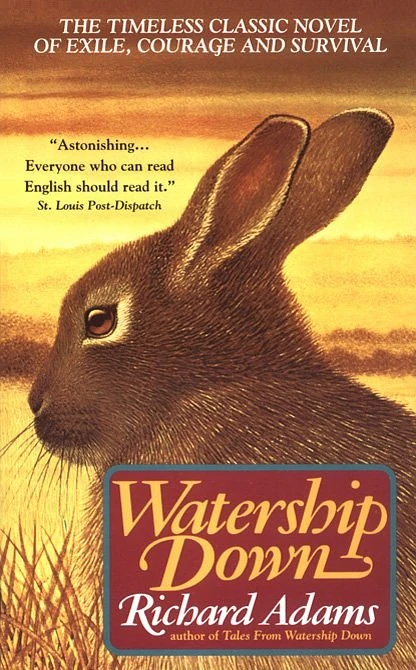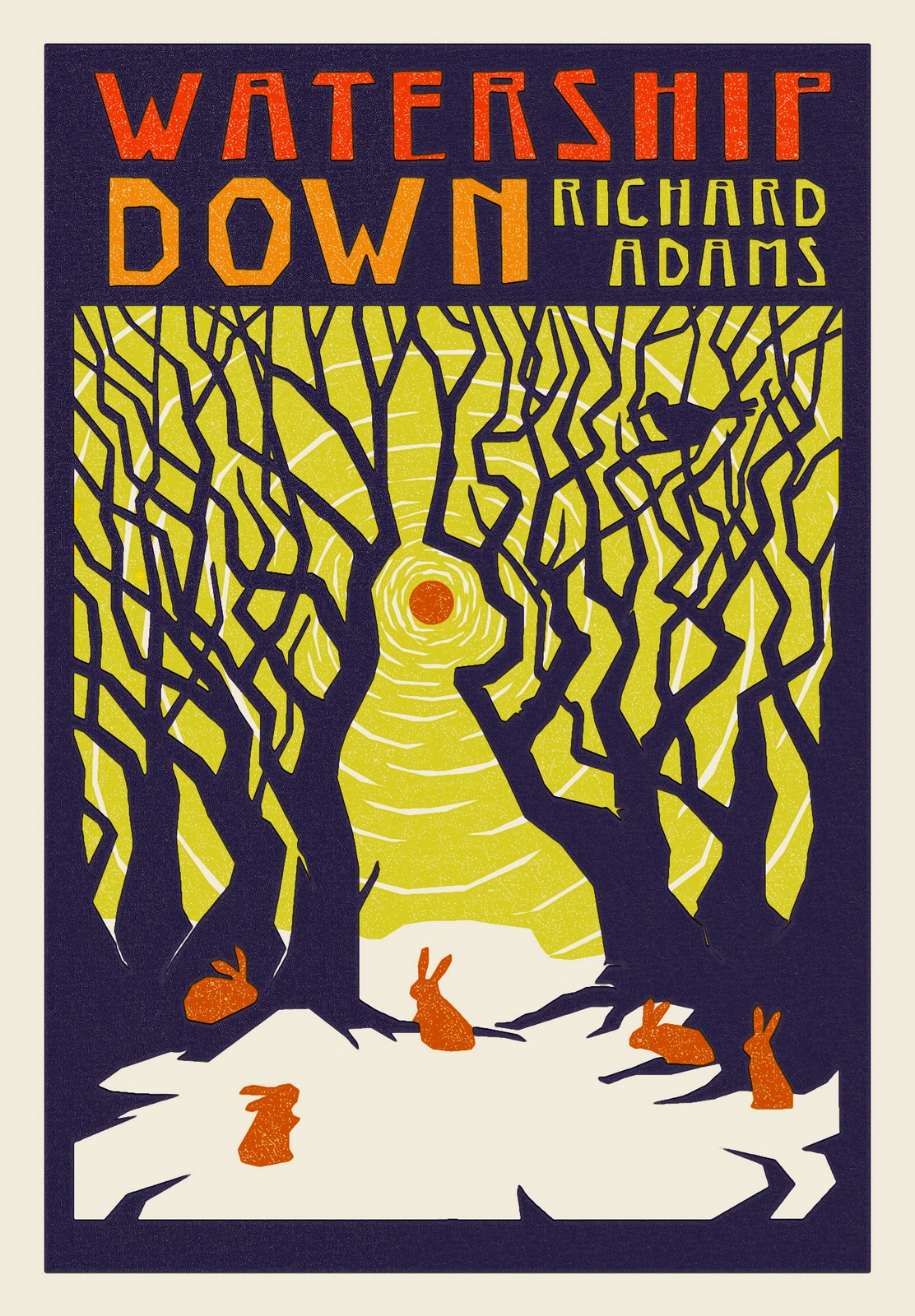This is where it all began, not just for me, but for millions of other people all over the world. Out of all the works of animal fantasy, Watership Down is arguably the single novel of the genre with the biggest crossover appeal and success. The book has enchanted readers for over 40 years, and spawned two animated film adaptations (one for theaters and one for television).
 It wasn't the first, of course. As I've noted, the narrative convention of using non-human animals as protagonists or major supporting characters is as old as storytelling itself. But Watership Down had a singular impact on English-language literature, a monster best-seller across decades that became a foundational work for the hidden genre* of animal fantasy. It is likely that without its success, the world would never have had the proliferation of animal-driven novels and films for children or adults that it has since witnessed. Without Watership Down, there likely would never have been a Redwall, a Lion King, or a Guardians Of Ga'Hoole.
It wasn't the first, of course. As I've noted, the narrative convention of using non-human animals as protagonists or major supporting characters is as old as storytelling itself. But Watership Down had a singular impact on English-language literature, a monster best-seller across decades that became a foundational work for the hidden genre* of animal fantasy. It is likely that without its success, the world would never have had the proliferation of animal-driven novels and films for children or adults that it has since witnessed. Without Watership Down, there likely would never have been a Redwall, a Lion King, or a Guardians Of Ga'Hoole.*I call animal fantasy a "hidden genre" because its body of work is found nested within several other recognized genres, like children's literature, young adult, dramatic fiction, fantasy, sci-fi, and even horror, yet has distinct characteristics of its own that transcend these categories. Whatever their other narrative techniques, most of these works try not so much to anthropomorphize animal characters as to "animalize" the human reader's perceptions and empathy, making them identify with animal characters on their own, rather than on human, terms. Richard Adams does a masterful job at establishing this convention of animal fantasy in Watership Down, basing his characters' mannerisms and social interactions on the behavior of actual rabbits, yet convincing us human readers that we are one of them.
Others have reviewed Watership Down far more ably than me (here, here, and here are three particularly decent ones, for instance). What I want to do is show how this classic animal fantasy novel can be used to model a campaign for animal player characters.
Watership Down is essentially a sandbox hex-crawl through a stretch of the English countryside. Our Beast Master, Richard Adams, drew up a rough player's map, peopled it with interesting set and wandering encounters, then spurred his party of rabbit PCs to adventure by giving their Seer a disturbing vision that compels them to seek out a new home. It's virtually a textbook example of how to craft a sandbox setting and make it come alive, even though he had rabbits rather than humans in mind.
And it's the rabbit point of view that really counts here. Adams describes every location through the filter of a rabbit's senses of smell and hearing, often more vividly than he does using their sense of sight. This is important, because it highlights the fact that most mammals rely heavily on their sense of smell, with sight taking something of a back seat. In fact, primates -- including (demi-)humans -- are distinguished from other mammals by our diminished sense of smell, in favor of improved sight.
Adams accounts for this fact in very subtle ways, but it adds up to a distinctly "rabbitish" POV for the novel. And so it should be in a game of Great & Small, too. It is easy to fall back on human perceptions and describe every encounter to the players mainly by how it looks. But this would be anthropomorphizing their animal characters a tad too much. Sight is important for non-human animals, of course, but it's often secondary to their other senses. BMs wishing to foster a properly animal-centric feel to a G&S session should therefore try to "animalize" their players' conceptions by appealing first to senses other than sight.
Remember that most mammals have red-green color blindness. Birds and many fish can see into the ultraviolet range (remember "ultravision" from the 2nd Ed. DM's Guide?). Bats navigate by sonar (that is, hearing). Snakes "smell" and track by sense of taste.
Taking account of these senses in the descriptions you provide to players before telling them what they see -- as Adams often does with his presentation to the reader of a rabbit's world -- will go a long way to making their characters more than just crawling humanoids with the serial numbers filed off.
Another trick Adams pulls off subtly is showing how differently animals think from humans, while still keeping them relatable. He never gives the exact dimensions of any object or space that Hazel, Fiver, Bigwig, and the others encounter. He refers to any number larger than four as "lots" or "Thousands" (the name of the character Fiver is translated from a rabbit word meaning "Little Thousand," or "one more than four"; he was the fifth kitten born in his litter). Animals, or at least rabbits in Adams' story, aren't as precisely mathematical as humans can be.
This can be taken as a license to be vague or imprecise in mapping areas, depending on the species. Places or things will be "really big," "vast," "smaller than a cat but bigger than a squirrel," etc. Of course, it's probably still a good idea for the BM to keep as precise a picture of encounters as she wants, but there's no reason she has to share every single detail with the players' characters the way she might if they were (demi-)human.
 Finally, Adams shows rabbits struggling to do things that humans take for granted, like manipulate objects or deduce the function of simple mechanisms. BMs confronting their players with otherwise "mundane" tasks like turning a door knob, rolling over a rock, or flipping a switch, should call for lore checks. The Scout niche is designed to excel at these sorts of things, of course, but any animal should be given an opportunity to try.
Finally, Adams shows rabbits struggling to do things that humans take for granted, like manipulate objects or deduce the function of simple mechanisms. BMs confronting their players with otherwise "mundane" tasks like turning a door knob, rolling over a rock, or flipping a switch, should call for lore checks. The Scout niche is designed to excel at these sorts of things, of course, but any animal should be given an opportunity to try.On the other hand, animals should excel at things that (demi-)humans find difficult, such as three-dimensional navigation (for birds and fish and possibly arboreal species), acrobatics, or plant and animal lore for the local ecology. Animals have disadvantages compared to (demi-)humans in the OSR rules, but don't forget that even the simplest animal can do things from the start that (demi-)humans have to call on magic or technology to accomplish (how many other OSR games allow you to fly at 1st level?).
All that said, Watership Down also helps answer the most common question I've gotten when pitching this game to others: what do animal characters do?
Turns out, they do mostly what two-legged, sword-swinging characters do: go on quests, fight for honor and status, fall in love. There's no reason that a "standard" adventure or campaign idea can't be run with animal player characters. You just have to focus on the different ways they're likely to perceive your encounters.
There is one major difference, though, and that's stuff. Animals, in general, aren't interested in treasure or possessions for their own sake, the way (demi-)humans are. This removes a major adventuring motivation from the heart of the OSR experience, but I'll deal with how to manage that change in a future post.
No comments:
Post a Comment